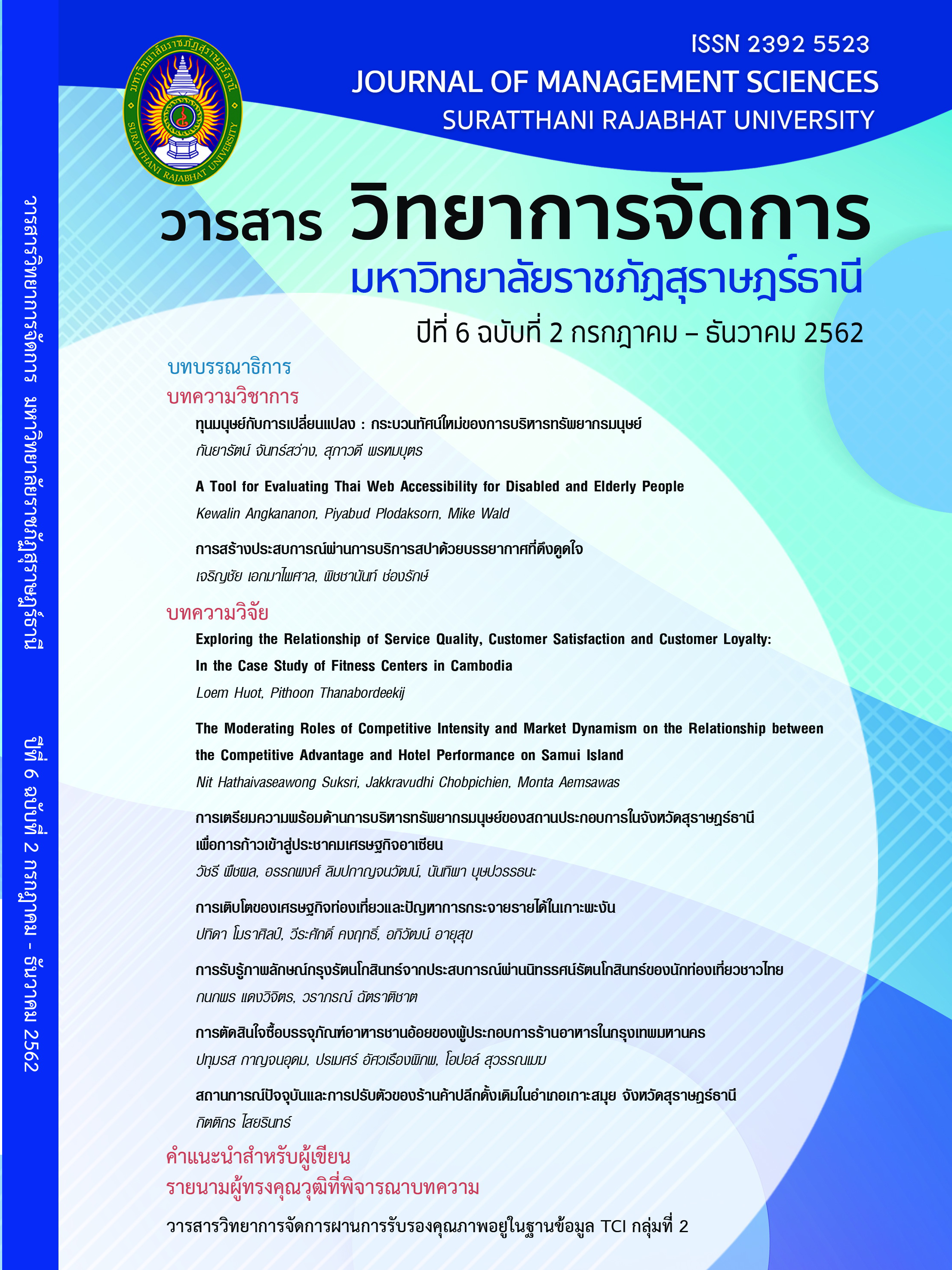The Moderating Roles of Competitive Intensity and Market Dynamism on the Relationship between the Competitive Advantage and Hotel Performance on Samui Island
Main Article Content
Abstract
This study developed the moderating roles of competitive intensity and market dynamism on the relationship between the competitive advantage and hotel performance under the theoretical framework of environment-strategy-performance relationship. The population of this study in the period between September 2013 and December 2013 was 246 hotels on Koh Samui and 154 executives. The results showed that the competitive intensity does not significantly moderate the relationship between the competitive advantages with hotel performance. On the other hand, the results showed that the market dynamism significantly moderates the relationship between the competitive advantages with hotel performance, except environmental performance. In addition, the type of the moderating roles of the market dynamism was quasi moderator.
Article Details
References
Azzone, G., & Bertele, U. (1994). Exploiting green strategies for competitive advantage. Long Range Planning, 27(6), 69 - 81.
Banerjee, S. B., Iyer, E. S., & Kashyap, R. K. (2003). Corporate environmentalism: Antecedents and influence of industry type. Journal of Marketing, 67(2), 106 - 122.
Barnett, W. P. (1997). The dynamics of competitive intensity. Administrative Science Quarterly, 42, 128 - 160.
Berman, S. L., Wicks, A. C., Kotha, S., & Jones, T. M. (1999). Does stakeholder orientation matter? The relationship between stakeholder management models and firm financial performance. Academy of Management Journal, 42(5), 488 - 506.
Bhat, V. N. (1996). The Green Corporation: The Next Competitive Advantage. Quorum Books, Westport, CT.
Cui, A. S., Griffith, D. A., Cavusgil, S. T., & Dabic, M. (2006). The influence of market and cultural environmental factors on technology transfer between foreign MNCs and local subsidiaries: A Croatian illustration. Journal of World Business, 41, 100 - 111.
Hair, J. F., Jr., Black, W. C., Babin, B. J., Anderson, R. E., & Tatham, R. L. (2006). Multivariate data analysis (6th ed.). Englewood Cliffs, NJ: Pearson/Prentice Hall.
Hofer, C. W. (1975). Toward a contingency theory of business strategy. Academy of Management Journal, 18(4), 784 - 810.
Jaworski, B. J., & Kohli, A. K. (1993). Market orientation: Antecedents and consequences. Journal of Marketing, 57(3), 53 - 70.
Judge, W. Q., & Douglas, T. J. (1998). Performance implications of incorporating natural environmental issues into the strategic planning process: An empirical assessment. Journal of Management Studies, 35(2), 241 - 262.
Leonidou, L. C., Leonidou, C. N., Fotiadis, T. A., & Zeriti, A. (2013). Resources and Capabilities as drivers of hotel environmental marketing strategy: Implications For competitive advantage and performance. Tourism Management, 35, 94 - 110.
Luo, Y., & Park, S. H. (2001). Strategic alignment and performance of market-seeking MNCs in China. Strategic Management Journal, 22, 141 - 155.
Lyon, T.P. (2003). ‘Green’ firms bearing gifts. Regulation, 26(3), 36 - 40.
Man, L. W. (2010). Corporate environmentalism and environmental strategies: The relationship between resources, capabilities, strategies and performance in Chaina’s Pearl River Delta. ProQuest Dissertations and Theses.
Mangena, M., & Pike, R. (2005). The effect of audit committee shareholding, financial expertise and size on interim financial disclosures. Accounting and Business Research, 35(4), 327 - 349.
McCloskey, J., & Maddock, S. (1994). Environmental management: Its role in corporate Strategy. Management Decision, 32(1), 27 - 32.
Menon, A., & Menon, A. (1997). Enviropreneurial marketing strategy: The emergence of corporate environmentalism as market strategy. Journal of Marketing, 61(1), 51 - 67.
Miles, M. P., & Covin, J. G. (2000). Environmental marketing: a source of reputational, competitive, and financial advantage. Journal of Business Ethics, 23(3), 299 - 311.
Miles, R. E., & Snow, C. C. (1978). Organizational strategy, structure and process. New York: McGraw-Hill.
Miller, D., & Friesen, P. H. (1983). Strategy-making and environment: The third link. Strategic Management Journal, 4(3), 221 - 235.
Moorman, C., & Rust, R. T. (1999). The role of marketing. Journal of Marketing, 63 (Special issue), 180 - 197.
Muller, D., Judd, C.M., & Yzerbyt, V.Y. (2005). When moderation is mediated and mediation is moderated. Journal of Personality and Social Psychology, 89(6), 852 - 863.
Murphy, P. R., Poist, R. F., & Braunscchweig, C. D. (1995). Role and relevance of Logistics to corporate environmentalism: An empirical assessment. International Journal of Physical Distribution & Logistics, 25(2), 5 - 19.
Nunnally, J. C. (1978). Psychometric theory. (2nd ed.). New York: McGraw-Hill, Inc.
Orsato, R.J. (2006). Competitive environmental strategies: When does it pay to be green? California Management Review, 48(2), 127 - 43.
Polonsky, M.J., Carlson, L., Grove, S., & Kangun, N. (1997). International environmental marketing claims. International Marketing Review, 14(4), 218 - 32.
Porter, M. E., & van der Linde, C. (1995). Green and competitive: Ending the stalemate. Harvard Business Review, 73(5), 120 - 134.
Russo, M. V., & Fouts, P. A. (1997). A resource-based perspective on corporate environmental performance and profitability. Academy of Management Journal, 40(3), 534 - 559.
Sarin, S., & Mahajan, V. (2001). The effect of reward structures on the performance of crossfunctional product development teams. Journal of Marketing, 65(2), 35 - 53.
Vorhies, D. W., & Morgan, N. A. (2005). Benchmarking marketing capabilities for sustainable competitive advantage. Journal of Marketing, 69(1), 80 - 94.
Zhou, K. Z., Brown, J. R., & Dev, C. S. (2009). Market orientation, competitive advantage, and performance. Journal of Business Research, 62(11), 1063 - 1070.
Zorn, T.E., & Collins, E. (2006). Green is the new black: Are CSR and sustainable business just fads?. Conference paper presented at the Australia-New Zealand Academy of Management Conference, Rockhampton.


